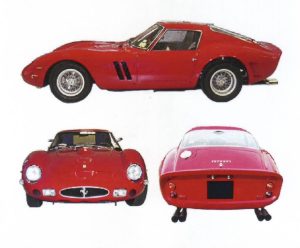Ferrari 250 GTO, produced between 1962 and 1964, is an iconic car. Only 36 cars were ever produced. They are also the most valuable collector cars in the world with a record-breaking sale price of 70 million USD in 2018.
The car has enormous value and goodwill for Ferrari, and there is no question that Ferrari has an interest in protecting it. Recent proceedings in the European Union Intellectual Property Office (EUIPO) highlight the difficulties involved.
In 2007 Ferrari applied to get the appearance of the car registered as a trademark. In 2008 the EUIPO registered the mark, shown below:

A Swiss company Ares Performance AG started cancellation proceedings in 2019. Ares applied to have Ferrari’s 3D trademark registration of the 250 GTO model cancelled for a) non-use, b) lack of distinctive character, and c) bad faith. The EUIPO has just given their first ruling in the case concerning non-use.
If a registered trademark is not used for a period of five years, it can be cancelled. In order to keep the registration alive if challenged, the owner must show that the mark has been used during the five year period for those goods that are covered by the registration.
The claim in cancellation proceedings was that Ferrari has not sold Ferrari 250 GTO cars for over 50 years and therefore the registration must be cancelled. In principle, it is possible in rare circumstances to establish the use of a trademark even though the products are no longer available, for example, for after-sales products (spare parts) or services (repair).
Although there have been several Ferrari 250 GTO sales taking place in the last 5 years (including the record-breaking 70 million EUR sale), they have taken place between other parties, not Ferrari. Ferrari has not sold the model for more than half a century and it had no influence or control over the sales that have taken place in the last 5 years. Ferrari also failed to show that the 3D trademark in question was used for after-sales products or services.
The EUIPO decided that the 3D trademark had only been used for toy vehicles and scale-model vehicles. For all other products, most importantly cars, the trademark was cancelled. Needless to say, the decision is a huge blow to the legal protection of the reputation of the Ferrari 250 GTO model.
The other cancellation action based on bad faith and lack of distinctiveness is currently suspended. Ferrari will undoubtedly appeal against the cancellation decision. If they are ultimately successful in their appeal(s) in the case concerning non-use, they will then have to defend the other cancellation action based on bad faith and lack of distinctiveness. That poses another set of difficulties that Ferrari must overcome.
To act or not to act
In 2018 Ares Design, an Italian company specializing in custom made luxury cars, announced that they would build a modern incarnation of the Ferrari 250 GTO. See further information here. Ferrari took legal action to stop Ares Design from making the incarnation and was eventually successful in obtaining an injunction ordering Ares Design to stop the work. As a countermeasure, Ares Performance (either a subsidiary or otherwise affiliated company to Ares Design) filed the cancellation of Ferrari’s 3D trademark of the Ferrari 250 GTO model.
Whenever a company takes action against other companies, they run the risk of having its own intellectual property challenged. The same happened to McDonald’s when they took action against Supermac’s and as a result, had their own trademark registration for BIC MAC cancelled (the appeal is still pending).
Ferrari obviously knew that they had not used the 3D trademark for cars for nearly 60 years, so the risk of cancellation was surely taken into account before starting proceedings against Ares. Brand owners, whether they are large corporations or small startups, must always weigh the risk of losing their own intellectual property when claiming that others infringe it. If there are vulnerabilities such as non-use, companies should be very cautious in going after others. Often a better strategy is trying to negotiate with the adverse party.
How to preserve intellectual property in iconic designs
There is no question that Ferrari has a legitimate interest in protecting the reputation and goodwill of its iconic Ferrari 250 GTO by using all types of intellectual property available. The same applies to manufacturers of other products as well, such as furniture, lighting, apparel, and so on.
From a trademark point of view, the challenge is the 5-year rule. If the mark (in this case, the 3D shape of the product) is not used for 5 years, it can be cancelled. If Ferrari made a new collection of the old Ferrari 250 GTO model it could keep the trademark rights alive, but by doing so might dilute the reputation and value of the original 36 cars. Filing new applications every 5 years to avoid the use obligation is not a solution, because the EU courts have consistently held that these kinds of applications amount to “bad faith” (abuse of the system) and therefore can be invalidated. Also, there is a high threshold for 3D trademarks to be considered distinctive. It is not enough for the shape to be just a variant of a common shape, especially in industries where there is a diversity of designs, such as in the automobile industry.
Design registrations are not available for old iconic designs, because the design has to be new at the time it is registered. Also, the length of protection is often inadequate for truly iconic designs. If Ferrari 250 GTO was registered as a design in 1962, the protection would have lapsed already in 1987. For most new car models, design registration is a good form of protection and for most models, 25 years of protection is more than sufficient. For truly iconic designs that live for half a century or more, design registration is too limited in time.
Copyright is theoretically available, but it has two major challenges. First, there is uncertainty whether car shapes themselves are subject to copyright protection. Many countries are reluctant to give utilitarian objects copyright protection, or at least set a high bar for the originality requirement. This might be changing because of recent EU case law, and it might be that in future car companies will be better able to rely on copyright protection. The second challenge is that copyright protection might not be sufficiently strong to prevent modern incarnations of old classics, as it is possible to design around the original and thus avoid infringing copyright. Of course, this is also a challenge for companies like Ares Design. They must make the modern version resemble the original model enough, but make it sufficiently different. It’s not an easy line to draw.
Conclusion
Intellectual property is clearly not very well suited for preserving and protecting the goodwill of old iconic products that are no longer sold and manufactured by the original rights owner. Each type of protection (trademark, design, copyright) has its own limitations.



